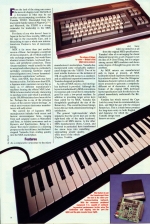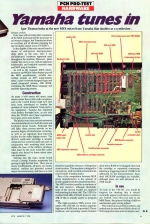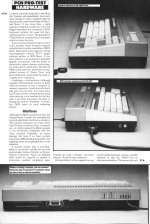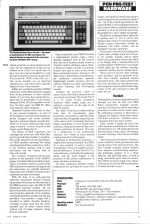
Personal Computer News
 17th March 1984
17th March 1984
Categories: Review: Machine
Author: Igor Thomas
Published in Personal Computer News #053
Igor Thomas looks at the new MSX micro from Yamaha that doubles as a synthesizer.
Yamaha Tunes In
Igor Thomas looks at the new MSX Micro from Yamaha that doubles as a synthesizer
From the land of the rising sun comes the news of a happy event: the birth of a forerunner in what may be yet another microcomputing revolution, the Yamaha YIs503. Descended from the inscrutable family names of Nippon Gakki and Microsoft, the YIS503 is a strong contender for leadership in the MSX stakes.
For those of you who haven't been to Japan in the last three months, MSX is all the rage in the inscrutable East, and is threatening to open a whole new international-size Pandora's box of microcomputing.
MSX is far more than just another version of Basic. Just imagine a world full of microcomputers, all of which could not only exchange programs, but would have identical screen formats, keyboard functions, and peripheral connectors. These 'dream-machines' would actually be able to accept each other's plug-ins, particularly cartridges containing hardware expansions and games (sorry, I mean 'dynamically interactive applications') software.
Now, with MSX, that dream may have become a reality. For little more than $250, a Japanese micro customer can now buy as many as 15 different manufacturer's machines bearing the official MSX label. With its home market already clamouring to purchase every unit which is produced, nearly 100,000 machines have been sold so far. Perhaps this is one of the principal cuases of the current 'silicon shortage' to which most western electronics manufacturers will sadly attest.
The current list of Japanese MSX manufacturers includes both recent and historic microcomputer firms, ranging from such sanguine names as Matsushita and Sony, to relative newcomers such as Kyocera and Spectravideo. Being in a classic 'first micro' position is a daunting prospect at the best of times, but this hasn't stopped Yamaha from striding quickly into the MSX marketplace.
Features
As a comparative newcomer to the micro manufacturer's marketplace, Yamaha has incorporated some remarkably sophisticated design into the YIS503. Two of its most notable features are the inclusion of 32K of usable RAM memory as standard, and an additional expansion connector for Yamaha-designed peripherals.
As with all MSX micros a full moving-key keyboard is provided. Although the layout is standardised by MSX conventions its response and overall feel is remarkably good for such a low-priced machine. In addition to providing larger arrow keys than called for by MSX, Yamaha has thoughtfully quadrupled the size of the RETURN key. The overall keyboard design leaves the user with a wholesome feeling of satisfaction.
The general 'right-hand-rule', which stipulates that the arrow keys are on the right-hand side of the main keyboard, applies to all MSX micros. A few other MSX manufacturers (Sony, Canon, and National in particular) have transformed the arrow keys into something approaching arcade quality, while most of the others (Fujitsu, Toshiba, etc) have taken no initiative at all from the original MSX specifications. Yamaha's idea of re-arranging the classic diamond layout into a sort of square is not my idea of A Good thing, but it is unique among current MSX machines and shows some degree of thought has gone into the problem.
As MSX micros are manufactured only in Japan at present, all MSX keyboard include Japanese characters as a key-selected option. Once the Hiragana/Katakana character option is selected, the micro proceeds to generate a completely different set of characters. A worrying feature of the original MSX keyboard layout specification calls for this key to be placed immediately underneath the RETURN key.
Yamaha has wisely moved the CAPS LOCK key away from its recommended position, and filled the gap with the enlarged RETURN key. This is a much better prospect for long-term entry in both English and Japanese, for which the Yahama design team deserve an extra fortune cookie.
Only time will tell what other variations of the MSX keyboard will be necessary to suit western fingers, but Yamaha has done an excellent job of advance planning for the inevitable export users of YIS503's.
In the depths of the main circuit board a cluster of well-proven microprocessor chips attest to the easy, dare I say old-fashioned, hardware approach used throughout the machine. However, 'plain vanilla' this micro is not, with its ingenious windowable and bankable memory map and MSX plug-in facilities.
As well as the requisite Z80A micro-processor and 9928A video display (part of the MSX specification), notable microchips include an 8255 input/output/timer, a pair of custom-designed logic and sound-integrated circuits, 32K ROM, containing the MSX Basic language and machine Operating System.
Construction
As many a hi-fi owner will attest, most micros create havoc with radio reception, and in the United States tough new laws have been introduced to combat the problem of 'noise pollution' from electronic equipment. Yahama has displayed even further foresight here, as not only does the YIS503 meet these regulations, but it goes a few steps further.
The plastic outer case conceals extensive internal metalwork over both the main and keyboard circuit boards. Although thin and light, these screens provide an impressive degree of interference screening, as well as an ingenious heat-removing facility for the video display circuit. The SFG-01 synthesizer cartridge is actually constructed with matching steel screen within the base of the cabinet, produces what must be the most noise-free audio signals ever heard by home micro users cum musicians.
Delving into the main circuit boad reveals a strong Yamaha propensity for getting it right first time. There are no messy modifications, all parts are clearly marked, outlines are provided around major functional areas, and there is a total (bold but laudable) absence of integrated circuit sockets. This machine is designed to run and run, with very little attention from your friendly Yamaha dealer.
Part of the competition between MSX micro manufacturers is the amount of RAM supplied with the standard machine. The MSX standard specifies a minimum of 8K user memory, although thankfully none of the current models are supplied with anything less than 16K. the YIS503 is credited with 48K of RAM, however only 32K of this is actually usable as program area.
The high-resolution MSX screen consumers 16K of RAM, for which a separate high-speed RAM bank is provided. Clever hardware and Operating System features allow extra RAM to be plugged onto both the cartridge or expansion connectors, allowing a staggering total of 1,024K to be addressed by the microprocessor. Standard 16K RAM cartridges are available, although plans are well advanced on a 256K model.
In Use
To look at the YIS-503 you would be forgiven for thinking that it doesn't outwardly appear particularly revolutionary. Indeed, even when you start to use MSX Basic, the general feeling of deja vu can become quite strong indeed.
This impression is perfectly natural, and indeed may be intentional (think about it)! Not being a first-time microcomputer user, I actually enjoyed being able to switch on the Yamaha, and immediately feel confident enough to write a program with my already hard-earned knowledge of Microsoft Basic. It was more than a slight surprise to find how readily my well-worn fingers found their way around the YIS503 keyboard without the usual full day's "getting used to it" torture. The general feel of the hardware reminded me of machines easily ten times the price.
It was only a few minutes work to create a really playable Space Invaders program using the built-in sprite capabilities of MSX Basic. This feature alone suggests a strong encouragement towards DIY games software written in MSX Basic. A few more minutes work produced a plausible graphic art program, with the ability to draw circles, elipses, squares and rectangles, all in solid or outline form. The built-in MSX sound generator performed accomplished versions of 'Funky Town' with great enthusiasm; programmed as easily as a simple PRINT statement.
Combining a tried-and-true (although arguably old-fashioned) version of Basic with the potential of over a *megabyte* of memory expansion, I really started to feel a silly grin cross my face. Too many times have I had to learn everything from scratch when meeting a new machine for the first time. I am surely not going to be alone in finding the built-in 'familiarity' of Yahama's MSX micro its most endearing feature.
Interfaces
Although the MSX specification does not demand them, Yamaha has included both joystick and printer interfaces as standard. The joystick connectors are of the classic 9-pin D-type as used by Atari, Commodore, etc, but be warned: the MSX stndard is not electrically compatible with the Atari standard. Hopefully, no major damage will occur if an Atari joystick is used in an MSX machine by accident, but adapting cables are required if this is your intention.
A parallel printer port is provided, which is electrically suitable for use with most popular makes of printer, e.g. Epson, Seikosa, Centronics. again, an adapting cable would be required to connect a Centronics standard peripheral since Yamaha has used a cheaper, but more obscure, 14-pin JIS-type connector.
Delving further in the compact but not overcroweded hardware reveals a notable omission in that the YIS503 has no television modulator. This means that only a black and white or colour monitor can be used, but the implications of this are not without merit. (Also, it is much easier to have your own external modulator, to suit the type of television system you may have - PAL in the UK, NTSC in the USA, etc.). Our review machine was an imported Japanese unit, and comes with a specially adapted Luxor colour monitor.
Suffice it to say that the standard 16MSX colours are wonderfully displayed, ranging from strong primaries to more delicate shades. It is not clear how much improvement may be permissible to the merely adequate 256 by 192 pixel graphics resolution, but then again, the IBM PC offers very much the same standards.
Hopefully Yamaha will be able to offer its own external modulator, as most of the modulators currently on the market are poorly designed and would probably degrade a television display considerably. However, be sure to think seriously about using a monitor. A micro as good as this merits a good display device.
The beauty of MSX expansions and cartridges lies in the ease with which they may be moved from machine to machine. Part of the character of each manufacturer's MSX machine surrounds the styling and placement of these connectors, such as in the National machine with its dual top-loaders and the Fujitsu with its side-entry model.
The 'cosmetic' variations pale by comparison to the potential of the IS503's unique Yamaha hardware module system. This is essentially a built-it version of the MSX expansion connector (the signals and pin connections are virtually identifcal), which allows the YIS503 to be dedicated to a particular peripheral concept.
With the help of its well-respected electronic instruments division Yamaha has produced what may well become top of the MSX accessory pops, the SFG-01 FM Synthesizer Interface module. All you have to do is slide a discreetly-placed cover away from the underside of the machine, and slip the hardware module into the gap provided. Very sensibly, a single bolt is provided to anchor Yamaha hardware cartridges in place such that the whole machine may be freely carried about, without risk of losing expensive things from its underside!
Once so installed, your YIS503 becomes a computerised electric organ, coincidentally equipped with all the remarkable and novel features usually found on Yamaha's widely sold home organs. Built-in firmware brings a wealth of automatic features into play as soon as the correct Basic commands are given. Among over 30 different pre-defined musical instruments, the synthesiser electronics generate frightening realistic clarinets and vibraphones (shame we couldn't take pictures of these haunting and foot-tapping sounds).
Combine the generous variety of preset voices with 8 music channels and all you need is a keyboard. The model YK-01 is a 3.5 octave 44-note polyphonic keyboard which simply plugs into a multi-pin connector on the edge of the SGF-01 module.
The 'pitch' of the keys is oddly reduced from that of conventional piano keyboards, presumably so that the whole keyboard does not greatly exceed the size of the micro itself. I constantly found my fingers attempting to travel further than necessary, being accustomed as they are to normal synthesiser keyboards. This may be a hinderance to the professional musician, but I think us lesser mortals could get used to it with practice.
Speaking of professional musicians, a slightly more advanced module, the SMD-01, is also available. It used to attach a Yamaha DX-7 to the now slightly overshadowed MSX micro. In brief: the DX-7 is a real synthesizer, sold widely through music shops, and the mind boggles at the potential of this potent combination of music and micro technology.
On both synthesiser modules further connections are provided for stereo hi-fi output, and inputs for further processing of external signals by the synthesizer electronics. All of the sounds generated by the standard MSX3-voice sound generator are still available while a synthesizer module is installed, so all in all you'd do well to buy the neighbours a year's supply of earplugs.
The built-in 'rhythm generator' takes a bit of getting used to, but if you're into Japanese disco music it's time to get funky. Further eastern innovations include an automatic 'left hand' routine, and an intelligent 'bass line' generator.
If you aren't interested in learning how to play music, perhaps you'd care to invest in yet another Yamaha add-on which allows you to play music without any effort at all. Simply slide a Yamaha Play-Card reader (which plugs into the software cartridge connector) and hey presto, instant talent.
There cards are sued by other Yamaha music products, and are generally available from suitably advanced musical instrument shops. The card is printed with the words and music of your chosen tune, and a magnetic strip along the bottom edge carries all the data necessary to play the music for you.
Verdict
Although the academics and perfectionists amongst you may be irate over MSX Basic's peculiarities, Yamaha's accountants have not been slow off the mark when pressed for a solution to the 'master plan'. By inflinchingly pointing to Microsoft as arguably the suppliers of the most widely-sold Basic interpreter, Yamaha's microcomputing future has been assured.
Sadly, neither Yamaha nor any of the other Japanese manufacturers would commit themselves to a UK launch date by the time this article went to press, but chances are that Christmas 1984 will see an MSX battle.
Any motorcyclist will attest to Yamaha's street credibility, while pop musicians will sing the praise of its musical prowess. The new Yamaha computer greatly benefits from JApanes manufacturing expertise, and marketing acumen. It is a clean, efficient, and well-built micro, as well as being remarkably good value for money. The YIS503 certainly stands every change of taking the lead in the MSX marketplace for many months to come.
Technical Specifications
| Price: | Unknown, but probably between £150 and £200 |
| Processor: | Z80 |
| RAM: | 32K usable, plus 16K video |
| ROM: | 32K (BASIC and Operating System) |
| Screen: | 40 characters by 24 lines, 256 x 192 resolution |
| Keyboard: | 72 keys, English and Japanese characters |
| Interfaces: | Cartridge connector, expansion connector, joystick sockets, parallel printer interface, RGB monitor |
| Operating System: | MSX |
| Distributor: | Not yet announced |
This article was converted to a web page from the following pages of Personal Computer News #053.





